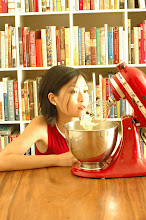Macaron Classes at Shermay's
 It's taken quite a few months to plan, but I'm really psyched about teaching a new class at Shermay's Cooking School ... Macarons & Biscotti, a demo class, will be held on 12 May 2007 (Saturday) and 13 May 2007 (Sunday). The May schedule has all the details; for inquiries, call +65 6479 8442 or email shermaycs@yahoo.com.sg.
It's taken quite a few months to plan, but I'm really psyched about teaching a new class at Shermay's Cooking School ... Macarons & Biscotti, a demo class, will be held on 12 May 2007 (Saturday) and 13 May 2007 (Sunday). The May schedule has all the details; for inquiries, call +65 6479 8442 or email shermaycs@yahoo.com.sg.There are many reasons I feel both excited and privileged to be doing so, but chiefly, it's because I am a bit fixated on macarons, those jewel-like confections that take pride of place in the lavish window displays of Paris' best pâtisseries. Whether it's being on the constant lookout for the ultimate fix, hinting to a loved one to do so on one's behalf, losing sleep over glitches, losing sleep over the quest for new best practice, there are few things I won't do in the name of eating or making a better macaron.
I learnt how to make macarons by making mistakes aplenty and learning from those mistakes. A distillation from my own experiences, I hope to show not just how to make macarons, but how to avoid those potential pitfalls that give macarons a largely undeserved rep as a tough cookie for home bakers to do. In truth, it really isn't rocket science, but macarons do demand of you time and patience - both of which are richly rewarded when you behold perfectly smooth domes with their frilly skirting (referred to as the "foot") and sink your teeth through that eggshell-thin crust to find a moist and utterly luscious interior.
The class will cover 4 classic macaron flavours:
 Chocolate Macarons filled with Valrhona Araguani 72% Dark Chocolate Ganache
Chocolate Macarons filled with Valrhona Araguani 72% Dark Chocolate Ganache Hazelnut Macarons filled with Valrhona Jivara Lactée 40% Milk Chocolate Ganache
Hazelnut Macarons filled with Valrhona Jivara Lactée 40% Milk Chocolate Ganache Vanilla Macarons with Vanilla Bean Buttercream
Vanilla Macarons with Vanilla Bean Buttercream(buttercream made via method using pâte à bombe)
 Coffee Macarons with Coffee Buttercream
Coffee Macarons with Coffee Buttercream (buttercream made via method using pâte à bombe)
When it comes to cookie-like things to go with tea or coffee, she who is apt to make her own macarons is also apt to make her own biscotti. So to round off the fairly intensive class, a light, crisp and delicate biscotti recipe that, by comparison, is a real doddle to pull off so long as a few essential pointers (which will be covered during the session) are kept in mind.
 Hazelnut & Cinnamon Biscotti
Hazelnut & Cinnamon Biscotti (with other ideas for easy flavour variations, and optional Chocolate Glaze)










